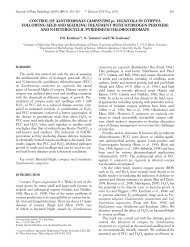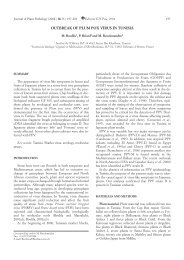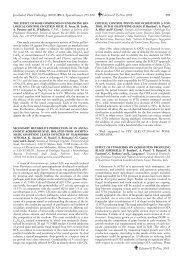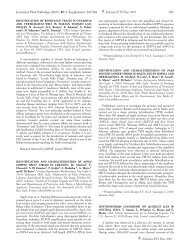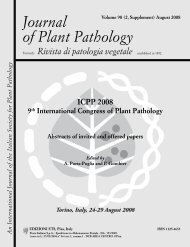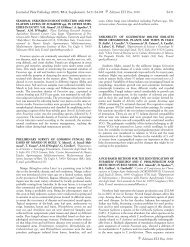Journal of Plant Pathology - Sipav.org
Journal of Plant Pathology - Sipav.org
Journal of Plant Pathology - Sipav.org
Create successful ePaper yourself
Turn your PDF publications into a flip-book with our unique Google optimized e-Paper software.
<strong>Journal</strong> <strong>of</strong> <strong>Plant</strong> <strong>Pathology</strong> (2011), 93 (1, Supplement), S1.19-S1.26 S1.25<br />
106, 111, 114, and 127), the production <strong>of</strong> type B trichothecenes<br />
was completely suppressed.<br />
PUCCINIA STRIIFORMIS ANALYSIS BY SEQUENCE RE-<br />
LATED AMPLIFIED POLYMORPHISM. M. Pasquali 3 , H.<br />
Komjati 2 , D. Lee 1 and R. Bayles 1 . 1 National Institute <strong>of</strong> Agricultural<br />
Botany, Huntingdon Road, Cambridge CB3 0LE, UK. 2 Szent<br />
Istva´n University, <strong>Plant</strong> Protection Institute, Gödöllö, Hungary.<br />
3 Centre de Recherche Public- Gabriel Lippmann, Département Environnement<br />
et Agro-biotechnologies, 4422 Belvaux, Luxembourg.<br />
E-mail: pasquali@lippmann.lu<br />
Yellow rust, caused by the fungal pathogen Puccinia striiformis,<br />
is a major disease <strong>of</strong> wheat in temperate-cool climates. The<br />
pathogen exists as a large number <strong>of</strong> ‘physiologic races’ possessing<br />
virulence for different resistance genes in host cultivars. The traditional<br />
method used for testing rust populations using a set <strong>of</strong> differential<br />
cultivars is time-consuming. As such, any molecular tool<br />
that <strong>of</strong>fers a quick method for primary screening yellow rust populations<br />
would be welcomed. Ideal markers used for pathogen<br />
identification would be based on the genes responsible for virulence.<br />
Here we present the use <strong>of</strong> a promising molecular approach<br />
for identifying and developing race-specific markers. The technique,<br />
SRAP, is based on the use <strong>of</strong> degenerate random primers. It<br />
has been shown that the primers used, preferentially target the exon–intron<br />
junction <strong>of</strong> genes in plants. To identify markers that can<br />
be useful to differentiate races <strong>of</strong> the pathogen, a subset <strong>of</strong> twelve<br />
single pustule isolates was first tested for pathogenicity and secondly<br />
analysed for their molecular pr<strong>of</strong>ile obtained using the<br />
SRAP technique with 9 primer combinations. It was possible to<br />
generate a 30% higher level <strong>of</strong> polymorphism compared to AFLP<br />
and it was possible to identify bands specific for single isolates<br />
that differ for the avirulence genes. These results suggest that<br />
SRAP may be suitable for the identification <strong>of</strong> pathogencity-related<br />
markers in pathogens such as yellow rust and represents the<br />
first application <strong>of</strong> the technique to the order Uredinales.<br />
COMPARISON OF FUSARIUM GENETIC CHEMOTYP-<br />
ING METHODS. M. Pasquali, M. Beyer, T. Bohn and L. H<strong>of</strong>fmann.<br />
Centre de Recherche Public-Gabriel Lippmann, Département<br />
Environnement et Agro-biotechnologies, 41, rue du Brill,<br />
4422 Belvaux, Luxembourg. E-mail: pasquali@lippmann.lu<br />
Fusarium chemotyping is an essential tool for characterizing<br />
Fusarium populations causing Head blight on wheat and other cereals.<br />
The chemotype determination <strong>of</strong> F. graminearum and F. culmorum<br />
was shown to improve the precision <strong>of</strong> prediction <strong>of</strong><br />
Fusarium toxin contamination in the field. Moreover, it is useful<br />
for defining the population structure <strong>of</strong> the pathogens within a<br />
field. Chemotyping methods for trichothecene type B discrimination<br />
in Fusarium have been developed for F. graminearum and F.<br />
culmorum. All methods are based on differences in the tri cluster<br />
that encodes the genes necessary to synthesize toxin variants (nivalenol,<br />
3 acetylated deoxynivalenol and 15 acetylated deoxynivalenol).<br />
Three methods were compared, using DNA obtained<br />
from previously isolated F. graminearum strains as developed by<br />
Ward et al. (2002), Quarta et al. (2006) (derived from Jennings et<br />
al., 2004), and Li et al. (2008). The methods, all based on polymorphisms<br />
<strong>of</strong> the tri cluster between the three known chemotypes<br />
are targeting tri 3, tri 7, tri 12 and tri 13. In order to verify specificity<br />
<strong>of</strong> the chemotyping tests and consistency <strong>of</strong> the markers, a<br />
set <strong>of</strong> 110 isolates from the CRP-GL collection belonging to F.<br />
graminearum, F. culmorum as well as control strains belonging to<br />
F. poae and F. avenaceum were analysed using the three above cited<br />
methods. PCR programs were modified to increase specificity<br />
<strong>of</strong> Phusion Taq, raising temperature <strong>of</strong> the annealing and denaturing<br />
steps. The three methods were not always consistent in<br />
chemotype attribution. In particular, differences were observed at<br />
the level <strong>of</strong> amplification specificity. When primers were used to<br />
amplify F. poae and F. avenaceum DNAs aspecific products were<br />
seldom amplified by Ward et al. (2002) and Quarta et al. (2006)<br />
methods. Wang’s method showed a lack <strong>of</strong> specificity being unable<br />
to distinguish correctly all the 3ADON and 15ADON isolates.<br />
This suggests that tri13 intron size cannot be used to distinguish<br />
acetylated chemotypes. This work highlights the fact that genetic<br />
chemotype determination requires a continuous monitoring<br />
<strong>of</strong> markers and that targeting different regions <strong>of</strong> the cluster may<br />
be the most reliable strategy for correct chemotype attribution.<br />
Moreover, none <strong>of</strong> the tested markers can be used on direct plant<br />
extracts that are <strong>of</strong>ten contaminated by multiple Fusarium species,<br />
giving raise to aspecific cross reaction products.<br />
Jennings P., Coates M.E., Turner J.A., Chandler E.A., Nicholson P.,<br />
2004. Determination <strong>of</strong> deoxynivalenol and nivalenol chemotypes<br />
<strong>of</strong> Fusarium culmorum isolates from England and Wales by PCR<br />
assay. <strong>Plant</strong> <strong>Pathology</strong> 53: 182-190.<br />
Quarta A., Mita G., Haidukowski M., Logrieco A., Mulè G., Visconti<br />
A., 2006. Multiplex PCR assay for the identification <strong>of</strong> nivalenol,<br />
3- and 15-acetyl-deoxynivalenol chemotypes in Fusarium. FEMS<br />
Microbiology Letters 259: 7-13.<br />
Wang J.-H., Li H.-P., Qu B., Zhang J.-B., Huang T., Chen F.-F., Liao<br />
Y.-C., 2008. Development <strong>of</strong> a generic PCR detection <strong>of</strong> 3-<br />
acetyldeoxy-nivalenol-, 15-acetyldeoxynivalenol- and nivalenolchemotypes<br />
<strong>of</strong> Fusarium graminearum clade. International <strong>Journal</strong><br />
<strong>of</strong> Molecular Sciences 9: 2495-2504.<br />
Ward T.J., Bielawski J.P., Kistler H.C., Sullivan E., O’Donnell K.,<br />
2002. Ancestral polymorphism and adaptive evolution in the trichothecene<br />
mycotoxin gene cluster <strong>of</strong> phytopathogenic Fusarium.<br />
Proceedings <strong>of</strong> the National Academy <strong>of</strong> Sciences USA 99: 9278-<br />
9283.<br />
PATHOGENICITY AND MYCOTOXIN PROFILE OF<br />
FUSARIUM TEMPERATUM, AN EMERGENT PATHOGEN<br />
OF MAIZE IN EUROPE # . J. Scauflaire 1 , M. Gourgue 1 , A.<br />
Callebaut 2 , L. Pussemier 2 and F. Munaut 3 . 1 Université<br />
Catholique de Louvain, Earth and Life Institute, Applied Microbiology,<br />
Laboratory <strong>of</strong> Mycology, Croix du Sud 3/6, 1348 Louvain-la-<br />
Neuve, Belgium. 2 Centre d’Etude et de Recherches Vétérinaires et<br />
Agrochimiques, Leuvensesteenweg 17, 3080 Tervuren, Belgium.<br />
3 Université Catholique de Louvain, Earth and Life Institute, Applied<br />
Microbiology, Mycothèque de l’Université Catholique de Louvain<br />
(BCCMTM/MUCL), Croix du Sud 3/6, 1348 Louvain-la-<br />
Neuve, Belgium. E-mail: Francoise.Munaut@uclouvain.be<br />
In a recent study, a population <strong>of</strong> Fusarium strains isolated<br />
from maize, closely related to F. subglutinans, was described as a<br />
new species, Fusarium temperatum J. Scauflaire et F. Munaut. In<br />
several temperate regions <strong>of</strong> Europe, the F. temperatum:F. subglutinans<br />
ratio is very high in the fields, suggesting that F. temperatum<br />
competes with its sister species F. subglutinans. This raised<br />
the question <strong>of</strong> the contribution <strong>of</strong> this novel species to the final<br />
ear rot or stalk rot symptoms observed on maize plants at harvest,<br />
as well as to the potential mycotoxin contamination. The pathogenicity<br />
<strong>of</strong> F. temperatum to maize plant has been tested in greenhouses<br />
and preliminary results confirm its ability <strong>of</strong> to cause stalk<br />
rot and seedling malformation with a virulence similar to that <strong>of</strong><br />
F. subglutinans. Currently, studies are in progress to elucidate the<br />
mycotoxigenic potential <strong>of</strong> F. temperatum.<br />
#<br />
Patholux Poster Award 2010



